🌍 Emerging Technologies 2026: The Innovations Changing Our World
Primary keyword: emerging technologies 2026
Related keywords: future tech trends, AI advancements, green technology, smart cities, digital transformation
Technology is evolving faster than ever — and 2026 is shaping up to be a game-changing year. From artificial intelligence breakthroughs to green energy solutions, these innovations are reshaping how we live, work, and connect.
🔹 Introduction: A World on the Edge of a Tech Revolution
Technology never stops evolving — and as we move closer to 2026, the pace of innovation feels faster than ever. From artificial intelligence shaping creative industries to green technology powering smarter cities, the next few years will redefine how we live, work, and connect.
We’re not just witnessing progress — we’re living inside it. In this post, we’ll explore the top emerging technologies of 2026 that are already reshaping industries and influencing our daily lives. Whether you’re a student, a professional, or simply curious about the future, these innovations are the ones to watch.
🤖 1. Artificial Intelligence: Your Everyday Digital Partner
Remember when AI felt like science fiction? Now it’s everywhere — from the moment you unlock your phone to the algorithms predicting what you’ll watch next. By 2026, artificial intelligence will be more than a tool; it will be a trusted partner in both personal and professional life.
- Personalized AI assistants that manage schedules, analyze productivity, and offer emotional support.
- AI-driven healthcare tools diagnosing illnesses and recommending treatments.
- AI in education creating customized learning paths for every student.
For tech professionals, mastering AI advancements and machine learning will be essential. For everyone else, it’s about learning to work with AI, not against it.
🌱 2. Green Tech: Building a More Sustainable 2026
The future of innovation isn’t just digital — it’s sustainable. Climate challenges are pushing countries and companies toward technologies that protect both the planet and the economy.
- Renewable energy storage — next-gen batteries and hydrogen fuel systems.
- Carbon capture and recycling turning emissions into usable materials.
- Smart farming using AI and IoT to optimize crops and reduce waste.
From solar-powered homes to eco-friendly transport systems, green technology will define global progress. This shift isn’t just about saving the planet — it’s about creating jobs, reducing costs, and building resilient communities.
🌆 3. Smart Cities: Technology Meets Urban Life
Have you ever imagined living in a city that seems to think for itself? Smart cities are no longer futuristic dreams — they’re becoming real, interconnected ecosystems.
By 2026, Internet of Things (IoT) devices will power:
- Traffic systems that adapt in real-time to congestion.
- Waste management that alerts collectors when bins are full.
- Energy grids that balance power consumption automatically.
These innovations make cities cleaner, safer, and more efficient — a major win for both people and the environment. From Singapore to Dubai, and even smaller towns, digital transformation is turning cities into living, learning systems.
🏭 4. Robotics and Automation: The New Workforce Revolution
If you thought robots were only for factories, think again. 2026 will be the year robotics steps into everyday life in ways we couldn’t have imagined.
- Manufacturing: collaborative robots (cobots) working alongside humans to speed up production.
- Logistics: autonomous drones and warehouse robots taking over repetitive jobs.
- Healthcare: robotic assistants helping doctors perform precision surgeries and assist elderly patients.
Automation may change the nature of work, but it also opens doors to new opportunities. The key is reskilling — learning how to manage, design, and collaborate with intelligent machines.
🌐 5. Quantum Computing: The Next Leap in Processing Power
Still in its early stages, quantum computing could redefine what’s possible in science, medicine, and cybersecurity by 2026.
Unlike traditional computers that use bits, quantum computers use qubits, performing calculations at extraordinary speeds. This could mean:
- Discovering new medicines in weeks instead of years.
- Creating unbreakable encryption for data security.
- Simulating global weather patterns with extreme precision.
While quantum computing isn’t mainstream yet, companies like Google and IBM are racing to make it accessible — and when they do, it’ll change everything.
🌍 6. The Human Side of Technology: Ethics and Balance
As powerful as these innovations are, they raise tough questions: How do we ensure AI ethics? Who controls personal data? What happens to jobs replaced by automation?
By 2026, tech ethics will be a central theme. Governments, companies, and individuals must collaborate to build transparency and fairness into every system. Technology should empower humanity — not exploit it.
🔭 7. What Lies Beyond 2026?
Looking ahead, the lines between physical and digital worlds will blur even further. We’ll see smarter homes, self-learning systems, and AI-driven sustainability efforts.
But here’s the real takeaway: the technologies that matter most aren’t just the ones changing industries — they’re the ones improving our quality of life.
✨ Conclusion: The Future Is Now
We don’t have to wait for the next decade — the future is unfolding right now. From AI to green tech, robotics to smart cities, each breakthrough brings us closer to a world that’s more connected, efficient, and sustainable.
Which of these emerging technologies excites you most about 2026?
Share your thoughts in the comments below and stay tuned to Worlds All in 1 for more insights on the trends transforming our world — one innovation at a time.

















.jpeg)
.jpeg)
.jpeg)
.jpeg)
.jpeg)
.jpeg)
.jpeg)
.jpeg)
.png)
.jpeg)
.jpeg)
.jpeg)

.jpeg)
.jpeg)
.jpeg)
.jpeg)
.jpeg)
.jpeg)
.png)
.jpeg)
.png)
.jpeg)
.jpeg)
.png)
.jpeg)
.jpeg)
.jpeg)
.jpeg)
.jpeg)
.jpeg)

.jpeg)
.jpeg)


